Swans, with their elegant presence and diverse species, captivate our imagination and hold unique places in cultures and ecosystems. Among these, white swans and black swans stand out, each distinct in appearance, behavior, and significance.
From the serene lakes of the Northern Hemisphere to the vibrant wetlands of Australia, these swans demonstrate remarkable adaptations and interactions with their environments.
Exploring their contrasting traits sheds light on the intricate connections between nature, symbolism, and human perception, unveiling a world where elegance, rarity, and adaptability intersect.
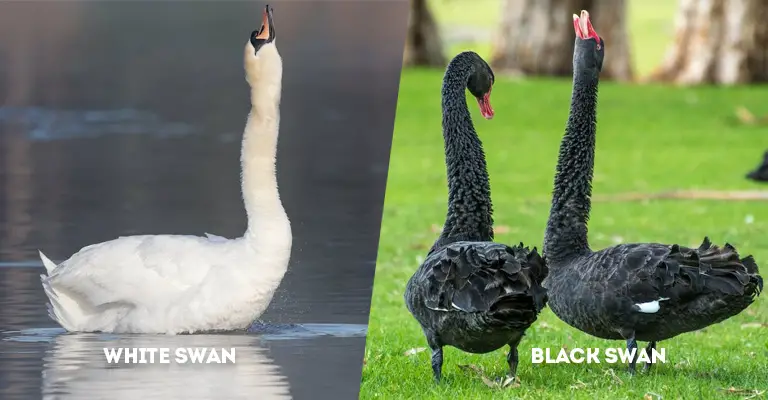
Key Differences Between White Swans and Black Swans
White Swans and Black Swans are two distinct types of swans that differ primarily in terms of their coloration, range, and cultural significance. Here are the key differences between them:
Distribution: White Swan vs. Black Swan
- White Swans: The white swans, with their pristine plumage, are often associated with the Northern Hemisphere. They can be found gracing lakes, rivers, ponds, and estuaries across regions like North America, Europe, and Asia.
Their presence in various cultures’ art and literature has perpetuated their image as symbols of elegance and beauty. - Black Swans: In stark contrast, the black swans are native to the captivating landscapes of Australia. These birds have carved their niche in the wetlands, lakes, rivers, and estuaries of the Australian continent.
The black swan’s uniqueness stems not only from its plumage but also from the historical significance attached to its discovery, challenging the conventional belief that all swans were white.
Plumage Color: White Swan Vs Black Swan
- White Swans: White swans, as their name suggests, are characterized by their gleaming white plumage. This coloration gives them a sense of purity and grace, aligning with the cultural symbolism they carry.
The pristine white feathers are often seen gliding gracefully on the water’s surface, evoking a sense of serenity. - Black Swans: The defining feature of black swans is their striking black plumage. The stark contrast of their dark feathers against the shimmering waters of Australian wetlands creates a captivating visual spectacle.
This unique coloration challenged established notions and led to the metaphor of “black swan events” signifying unexpected and rare occurrences.
Beak Color: White Swan Vs Black Swan
- White Swans: The beak of a white swan is a vibrant shade of orange with a black base. This combination of colors creates an eye-catching contrast against their white plumage. The beak’s coloration is not only functional but also adds a touch of vibrancy to its appearance.
- Black Swans: The beak of a black swan stands out vividly against its dark plumage with a bright red hue and a white tip. This distinct coloration serves as a beacon against the black backdrop and contributes to the bird’s unique allure.
Leg Color: White Swan Vs Black Swan
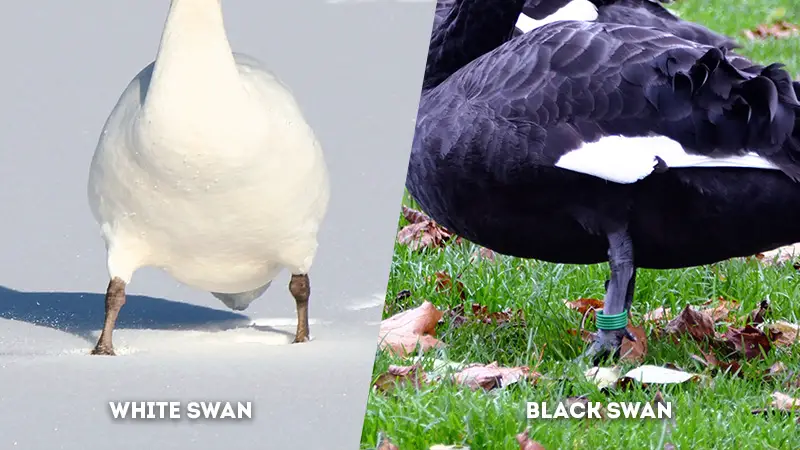
- White Swans: The legs of white swans typically match their plumage, appearing black or gray. This subtle coloration allows them to blend seamlessly with their surroundings, especially when wading through water.
- Black Swans: In contrast, the legs of black swans are also black, aligning with their dark overall appearance. This uniformity in color supports their adaptation to the Australian wetlands and adds to their distinctiveness.
Neck Length: White Swan Vs Black Swan
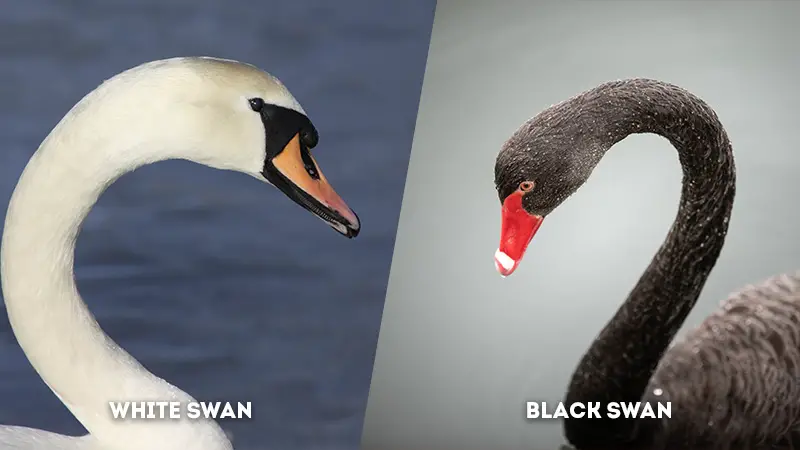
- White Swans: White swans are known for their moderately long necks, which add to their elegance. This elongated neck enhances their graceful movements both in water and during flight, contributing to their captivating demeanor.
- Black Swans: Similar to white swans, black swans also possess moderately long necks, which are well-adapted for their lifestyle in aquatic environments. The elongated neck aids in foraging, preening, and displaying various social behaviors.
Habitat: White Swan Vs Black Swan
- White Swans: With their ethereal white plumage and stately presence, white swans are often associated with the serene water bodies of the Northern Hemisphere.
These majestic birds can be observed gracing the landscapes of North America, Europe, and parts of Asia. They are commonly found in habitats such as calm lakes, slow-moving rivers, ponds, and estuaries. - Black Swans: In stark contrast, the enigmatic black swans are indigenous to the vast landscapes of Australia. Their natural habitat includes wetlands, lakes, rivers, and estuaries across the continent.
These dark-feathered avians blend seamlessly into the Australian waters, their striking contrast against the backdrop creating a visual spectacle.
Wing Span: White Swan Vs Black Swan
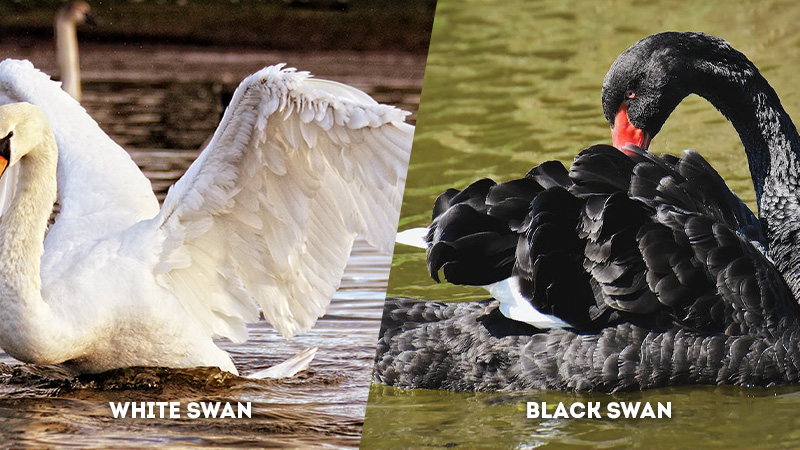
- White Swans: White swans exhibit varying wing spans, which generally lean toward the wider spectrum. Their wingspan aids in their graceful flight and enhances their ability to glide over water surfaces with ease.
This adaptability is a part of their charm, as they navigate different habitats while showcasing their impressive aerial movements. - Black Swans: Similar to their white counterparts, black swans also possess wingspans that facilitate their graceful flight. Their wingspan varies, allowing them to navigate the diverse Australian landscape, from wetlands to open waters.
This shared trait emphasizes the common evolutionary adaptations that enable swans to thrive in aquatic environments.
Behavior: White Swan Vs Black Swan
- White Swans: White swans are known for their social behavior and are often spotted in groups or pairs. They engage in activities such as synchronized swimming and communal feeding, fostering a sense of community within their gatherings.
These behaviors highlight their strong social bonds and cooperative interactions, enhancing their connection with their environment. - Black Swans: The behavior of black swans is comparable to that of white swans, as they too exhibit strong social tendencies. They are often seen in pairs or small groups, engaging in synchronized movements and cooperative foraging.
These behaviors not only enhance their chances of survival but also showcase the intrinsic social nature of these avian creatures.
Voice: White Swan Vs Black Swan
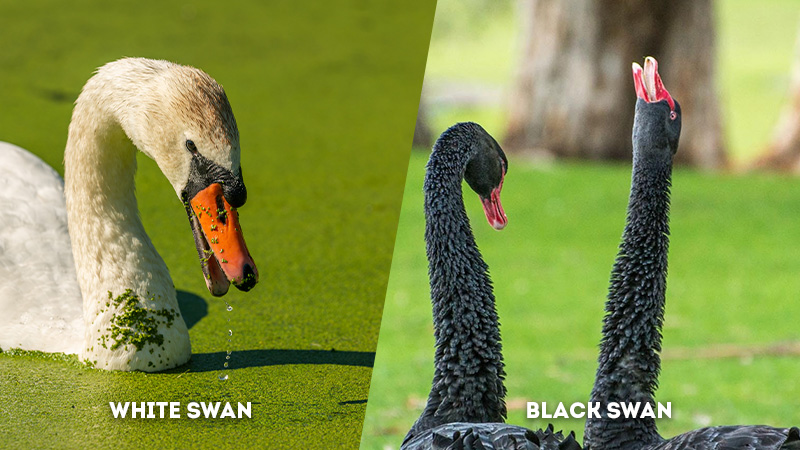
- White Swans: White swans are known for their varied vocalizations, which include a range of calls and trumpeting sounds.
These vocalizations serve various purposes, from communication within a group to expressing territorial dominance. The calls of white swans add an auditory dimension to their graceful presence and interactions. - Black Swans: Similarly, black swans are vocal birds with a diverse range of calls that contribute to their communication and social interactions.
Their bugling and honking calls are distinctive and can be heard echoing across Australian wetlands. These vocalizations are integral to their behavior and reflect their engagement with the environment.
Migratory Behavior: White Swan Vs Black Swan
- White Swans: While not all populations of white swans are migratory, some do exhibit migratory behavior. In certain regions, white swans undertake seasonal movements, seeking more favorable habitats during colder months.
This migratory behavior reflects their ability to adapt to changing environmental conditions and highlights their reliance on specific habitats. - Black Swans: In contrast, black swans are generally considered non-migratory birds. They tend to remain in their established habitats throughout the year, making the most of the Australian wetlands’ resources.
Their sedentary nature underlines their adaptation to the local environment and their ability to thrive within the constraints of their chosen habitat.
Nesting Habits: White Swan Vs Black Swan
- White Swans: White swans exhibit a remarkable penchant for building large nests. Constructed from various materials like reeds, grasses, and twigs, these nests are often situated on the water’s edge or on floating platforms.
The meticulous construction reflects their dedication to creating secure spaces for their young ones, where they can thrive and grow. - Black Swans: Black swans also demonstrate nesting behaviors that are well-suited to their Australian habitats.
They often build their nests close to water bodies, using aquatic vegetation and surrounding materials to create their structures. This proximity to water enhances their access to food sources and offers protection to their nests.
Egg Color: White Swan Vs Black Swan
- White Swans: The eggs of white swans display a range of colors, usually off-white to pale brown. This natural variation in egg coloration helps camouflage the eggs within the nest, offering some protection from potential predators. The subtle hues of the eggs blend harmoniously with the nesting environment.
- Black Swans: In contrast, the eggs of black swans are notably different, with a greenish-black to pale-brown coloration. This distinct coloring aligns with their dark plumage and the aquatic surroundings in which their nests are typically located. The coloration of their eggs is yet another adaptation that aids in their survival.
Incubation Period: White Swan Vs Black Swan
- White Swans: The incubation period for white swan eggs is approximately 35 days. During this time, the adult swans take turns incubating the eggs, sharing the responsibility of maintaining optimal conditions for successful hatching.
This cooperative behavior showcases their commitment to ensuring the survival of their offspring. - Black Swans: Similarly, the incubation period for black swan eggs is also around 35 days. During this period, the parents maintain the nest, regulate temperature, and protect the eggs from potential threats. The dedication of both parents contributes to the overall reproductive success of the species.
Parental Care: White Swan Vs Black Swan
- White Swans: White swans are exemplary in their approach to parental care. Once the eggs hatch, both parents actively participate in caring for the young cygnets. They provide protection, guidance, and nourishment, ensuring that the vulnerable young birds have the best chance of survival.
- Black Swans: Black swans share a similar commitment to parental care. After the eggs hatch, both male and female black swans engage in caring for the cygnets. Their collaborative efforts involve teaching the young birds essential skills for survival, such as foraging and avoiding potential dangers.
Young Swans: White Swan Vs Black Swan
- White Swans: Young swans, often referred to as “cygnets,” emerge from the eggs with a covering of downy feathers. These fluffy feathers provide insulation and warmth, keeping the cygnets comfortable during their early stages of development.
As they grow, their feathers gradually transition into the mature plumage characteristic of adult white swans. - Black Swans: Similar to white swans, black swan cygnets also possess downy feathers upon hatching. These feathers protect them from temperature fluctuations and provide buoyancy in the water. As the cygnets mature, their downy feathers give way to the glossy black plumage that defines the adult black swans.
Feeding Habits: White Swan Vs Black Swan
- White Swans: White swans are primarily herbivorous, relying on a diet consisting of aquatic plants, algae, and submerged vegetation. They use their long necks to reach underwater plants, their specialized bill allowing them to filter out food from the water.
This feeding strategy is essential for maintaining their energy levels and supporting their graceful movements on water bodies. - Black Swans: Black swans also follow herbivorous feeding habits, consuming aquatic vegetation and algae as their main food source.
Their long necks aid them in reaching underwater plants, showcasing their adaptation to their watery habitats. These feeding behaviors emphasize the ecological role of swans in maintaining aquatic ecosystems.
Flight Ability: White Swan Vs Black Swan
- White Swans: White swans are powerful fliers, capable of covering long distances during migration or in search of suitable habitats. Their wide wingspan and strong muscles enable them to achieve sustained flight, contributing to their versatility and ability to navigate varying landscapes.
- Black Swans: Similarly, black swans possess strong and agile flight capabilities. Their well-developed wing muscles facilitate efficient flight, allowing them to traverse the diverse Australian terrain. While they may not undertake extensive migrations like some other bird species, their flight skills remain integral to their survival.
Symbolism: White Swan Vs Black Swan
- White Swans: White swans have long been associated with elegance, grace, and beauty. Their serene presence on calm waters has inspired cultural and artistic representations, often symbolizing purity and tranquility.
They have captured human imagination through myths, literature, and visual arts, serving as a testament to the harmony found in nature. - Black Swans: The black swan holds a unique and contrasting symbolism. Due to their rarity and unexpected presence in Australia, the term “black swan” has come to represent unforeseen events that challenge established beliefs.
This metaphorical use highlights the impact of discovering the unexpected and the complex interactions between humans and the environment.
Cultural Significance: White Swan Vs Black Swan
- White Swans: White swans have played a significant role in various cultures around the world. They are revered for their elegance and often feature prominently in folklore, myths, and religious narratives. In many societies, swans represent beauty, fidelity, and the transcendent nature of love.
- Black Swans: Black swans hold particular cultural significance in Australia. As a native species, they are celebrated as an emblem of the continent’s unique wildlife.
They are depicted in art, literature, and national symbols, representing the distinctive qualities and adaptations that define Australia’s natural heritage.
Conservation Status: White Swan Vs Black Swan
- White Swans: The conservation status of white swans varies depending on the specific species and their geographical populations.
Some populations of white swans are considered of “Least Concern” by the International Union for Conservation of Nature (IUCN), while others may face threats such as habitat loss, pollution, and human disturbances. - Black Swans: Similarly, black swans are generally categorized as “Least Concern” by the IUCN. Their status reflects their adaptability to their native Australian habitats and their relatively stable populations.
However, localized threats such as habitat degradation and interactions with introduced species can impact their survival in certain regions.
White Swan Vs Black Swan: Comparison Table
| Feature | White Swans | Black Swans |
|---|---|---|
| Distribution | Found in Northern Hemisphere | Native to Australia |
| Plumage Color | White | Black |
| Beak Color | Orange with black base | Bright red with white tip |
| Leg Color | Black | Black |
| Neck Length | Moderately long | Moderately long |
| Habitat | Lakes, rivers, ponds, estuaries | Wetlands, lakes, rivers, estuaries |
| Wing Span | Varies, but generally wide | Varies, but generally wide |
| Behavior | Social and often seen in groups | Social and often seen in groups |
| Voice | Varied calls, including trumpeting | Varied calls, including bugling |
| Migratory Behavior | Some migratory populations | Generally sedentary |
| Nesting Habits | Build large nests of vegetation | Build nests near water |
| Egg Color | Off-white to pale brown | Greenish-black to pale brown |
| Incubation Period | Around 35 days | Around 35 days |
| Parental Care | Both parents participate | Both parents participate |
| Young Swans | Called “cygnets” | Called “cygnets” |
| Feeding Habits | Herbivorous, feed on aquatic plants | Herbivorous, feed on aquatic plants |
| Flight Ability | Powerful fliers | Strong and agile fliers |
| Symbolism | Elegance and grace | Uniqueness and rarity |
| Cultural Significance | Often depicted in art and stories | Notable in Australian culture |
| Conservation Status | Varies by species and location | Least Concern (IUCN) |
Frequently Asked Questions
White swans tend to build their large nests near the water’s edge or on floating platforms in the Northern Hemisphere. On the other hand, black swans often construct their nests close to water bodies in their native Australian habitats, utilizing aquatic vegetation and surrounding materials.
Both white swans and black swans communicate through a range of vocalizations. White swans are known for their varied calls and trumpeting sounds, which serve purposes like communication within their group and asserting territorial dominance. Black swans, similarly, use a variety of calls, including bugling and honking, to communicate with each other and establish their presence in the Australian wetlands.
Yes, there are cultural variations in how these swan species are symbolized. While white swans often represent beauty and grace across many cultures, black swans hold a unique symbolism in Australia. They symbolize unexpected events and discoveries due to their rarity and the historical belief that all swans were white.
Both white swans and black swans exhibit strong flight abilities, but their flight patterns differ due to their habitats. White swans, found in the Northern Hemisphere, might undertake migratory flights between their summer and winter habitats. Black swans, being native to Australia, generally do not migrate extensively but use flight for various activities in their local wetland environments.
Yes, there are conservation efforts in place for both white swans and black swans. These efforts focus on preserving their habitats, mitigating human disturbances, and monitoring population trends. While the overall conservation status of both species is currently considered “Least Concern,” localized threats and habitat degradation highlight the need for continued vigilance to ensure their long-term survival.
To Recap
In the world of avian wonders, the white swan and black swan emerge as symbols of elegance and uniqueness. Through their distinct habitats, behaviors, and cultural significance, they remind us of nature’s boundless diversity.
These swans teach us that beauty can manifest in unexpected forms, and their stories reflect the delicate balance between human understanding and the mysteries of the natural world.
As they glide gracefully on tranquil waters or forage in captivating wetlands, these swans continue to inspire awe, inviting us to appreciate the intricate tapestry of life that surrounds us.